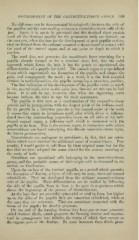Page 559 - My FlipBook
P. 559
DEVELOPMEST OF THE CONNECTIVE-TISSUE GROUP. 569
No difference can be demonstrated histologically between the cells of
the papillae and the snrrounding embryonic connective-tissue cells of the
jaw. Again, it is not to be presumed that this dentinal sheet i)ersists
until all the dentinal papillae for the permanent teeth are formed ; on
the contrary, when the time for the development of such papilla arrives,
they are formed from the ordinary connective tissue found in contact with
the cord of the enamel organ, and at any point or depth to Mhich it
reaches.
The cord does not penetrate the mesoblastic layer searching for a
papilla already formed or for a dentinal sheet, but, like the solid
ingrowth which forms the hair, it has the power to superintend the
ditiereutiation of a papilla for itself. The enamel organ is a specialized
tissue which superintends tlie formation of the papilla and shapes the
pulp, and consequently the tooth ; in a word, it is the tirst essential
element in tooth-formation, the papilla occupying a secondary position.
The first indication of the development of the pa])ill?e varies so much
in the sev^eral teeth, even in the same jaw, that no set rule can be laid
down. It is safe to say, however, that when the ingrowing cords
become bulbous the time is ripe for their appearance.
The papilla is first seen as a condensation of the connective tissue
outside and in juxtaposition with the deepest point of the bulbous cord.
By its growth in a direction opposite to the enamel organ of the tooth
it causes this organ to invaginate itself, after which there is differen-
tiated from the surrounding connective tissue, on all sides of the bell-
shaped enamel organ, a follicular wall which is connected with the
papilla at its base. This is the cement organ, in connection with which
cementoblasts are foUnd underlying this fibrous connective-tissue layer,
the future pericementum.
Cementoblasts are analogous to osteoblasts ; in fact, they are osteo-
blasts which have received the additional name of cementoblasts. Per-
sonally, I would prefer to call them by their original name but for the
fact that we have adopted the name cement for the osseous covering of
the roots of teeth.
Osteoblasts are specialized cells belonging to the connective-tissue
group, and the probable nature of their origin will be discussed in the
section on Ossification.
Upon the surface of the dentinal papilla, at a period which precedes
the formation of dentine, a layer of cells may be seen ; these are termed
odontoblasts. They are developed from the ordinary connective-tissue
cells of the papilla. Their differentiation can be studied by following
the side of the papilla from its base to its apex in a specimen which
shows the beginning of the process of dentinification.
At the base they are generally spheroidal or oval in form, but higher
up on the sides of the papilla they are somewhat cylindrical, while at
the apex they are columnar. They are sometimes connected with the
tissue of the papilla by slender processes.
On the side of the forming dentine they have one or more processes
called dentinal fibrils, which penetrate the forming dentine and superin-
tend its arrangement into tubules, the centre of which they occupy as
the organic part of the dentine. In some instances these fibrils pene-


